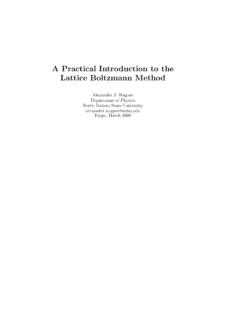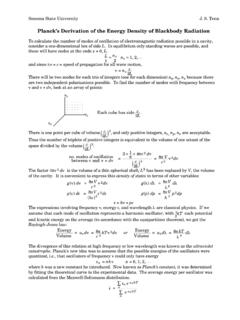Transcription of Chapter 4 The Statistical Physics of non-Isolated systems ...
1 Chapter 4. The Statistical Physics of non-Isolated systems : The Canonical Ensemble The boltzmann distribution The independent-particle approximation: one-body parti- tion function Examples of partition function calculations energy , entropy, Helmholtz free energy and the partition function * energy fluctuations Example: The ideal spin-1/2 paramagnet * Adiabatic demagnetization and the 3rd law of thermody- namics Example: The classical ideal gas Vibrational and rotational energy of diatomic molecules * Translational energy of diatomic molecules: quantum treat- ment The equipartition theorem * The Maxwell- boltzmann velocity distribution * What is next? 1. 4 The Statistical Physics of non-Isolated systems : The Canonical Ensemble In principle the tools of Chap.
2 3 suffice to tackle all problems in Statistical Physics . In practice the microcanonical ensemble considered there for isolated systems (E, V, N. fixed) is often complicated to use since it is usually ( , except for ideal, non- interacting systems ) very difficult to calculate all possible ways the energy can be split between all the components (atoms). However, we may also consider non-Isolated systems , and in this Chapter we consider systems in contact in with a heat reservoir, where temperature T is fixed rather than E. This then leads us to the canonical ensemble. In Chap. 3, we have introduced the canonical ensemble as many copies of a thermodynamic system, all in thermal contact with one another so energy is exchanged to keep temperature constant throughout the ensemble.
3 In this Chapter we will introduce the boltzmann distribution function by focusing on one copy and considering the rest copies as a giant heat reservoir: Canonical Ensemble = System + Reservoir. The important point to note is that for a macroscopic system the two approaches are essentially identical. Thus, if T is held fixed the energy will statistically fluctuate, but, as we have seen, the fractional size of the fluctuations 1/ N (we will verify this explicitly later). Thus, from a macroscopic viewpoint, the energy is constant to all intents and purposes, and it makes no real difference whether the heat reservoir is present or not, , whether we use the microcanonical ensemble (with E, V, N. fixed) or the canonical ensemble (with T, V, N fixed).
4 The choice is ours to make, for convenience or ease of calculations. We will see canonical ensemble is much more convenience. As we see below, the canonical ensemble leads to the introduction of some- thing called the partition function, Z, from which all thermodynamic quantities (P, E, F, S, ) can be found. At the heart of the partition function lies the Boltz- mann distribution , which gives the probability that a system in contact with a heat reservoir at a given temperature will have a given energy . 2. The boltzmann distribution Figure 1. Consider a system S in contact with a heat reservoir R at temperature T as shown in Figure 1. The whole, (R + S), forms an isolated system with fixed energy E0 . Heat can be exchanged between S and R, but R is so large that its temperature remains T if heat is exchanged.
5 We now ask: What is the probability pi that the system S is in a particular microstate with energy Ei ? We assume that S and R are independent of each other. The total number of microstates = R S . Now, if we specify the microstate of S to be the ith microstate, S = 1, we have = (E0 , Ei ) = R (E0 Ei ) 1. Thus, the probability pi of S being in a state with energy Ei depends on the number of microstates of R with energy E0 Ei , R (E0 Ei ) number of microstates of (S + R)with S in state i pi = pi (Ei ) = = . (E0 ) total number of microstates of (S + R). Now, use the boltzmann relation S = kB ln from Eq. (1) of Chap. 3, 1.. R (E0 Ei ) = exp SR (E0 Ei ) . kB. If R is a good reservoir it must be much bigger than S. So, let's Taylor expand around E0.
6 2 SR. ! ! SR 1. SR (E0 Ei ) = SR (E0 ) Ei + Ei2 + . E V,N E=E. 2! E 2 V,N. 0 E=E0. 3. But, from the thermodynamic relations involving partial derivative of S,, ! SR 1. = , E V,N. T. 2. ! " # ! SR (1/T ) 1 T 1. = = 2 = . E 2 V,N. E V,N. T E V,N. T 2C V. Thus, Ei Ei2. SR (E0 Ei ) = SR (E0 ) (R). + O(Ei3 ). T 2T 2 CV. (R). If R is large enough, CV T Ei and only the first two terms in the expansion are nonzero, " #. 1 SR (E0 ) Ei . pi R (E0 Ei ) = exp SR (E0 Ei ) = exp = const. e Ei /kB T. kB kB kB T. since SR (E0 ) is a constant, independent of the microstate index i. Call this constant of proportionality 1/Z, we have 1 Ei /kB T. pi = e , (1). Z. where Z is determined from normalization condition. So if we sum over all microstates X.
7 Pi = 1. i we have e Ei /kB T , X. Z= (2). i where sum on i runs over all distinct microstates. pi of Eq. (1) is the boltzmann distribution function and Z is called the partition function of the system S. As we will see later, partition function Z is very useful because all other thermodynamic quantities can be calculated through it. The internal energy can be calculated by the average 1X. Ei e Ei /kB T . X. hEi = Ei pi = (3). i Z i We will discuss calculation of other thermodynamc quantities later. We want to emphasize also that the index i labels the microstates of N-particles and Ei is the 4. total energy . For example, a microstate for the case of an spin-1/2 paramagnet of N. independent particles is a configuration of N spins (up or down): i = (.)
8 , ). For a gas of N molecules, however, i represents a set of values of positions and momenta as i = (r1 , r2 , .. , rN ; p1 , p2 , .. , pN ), as discussed in Chap. 3. [Ref.: (1) Mandl ; (2) Bowley and Sa nchez ]. The independent-particle approximation: one-body par- tition function If we ignore interactions between particles, we can represent a microstate of N-particle system by a configuration specifying each particle's oocupation of the one-body states, i = (k1 , k2, .. , kN ), (4). meaning particle 1 in single-particle state k1 , particle 2 in state k2 , etc., ( , the spin configurations for a paramagnet). The total energy in the microstate of the N. particles is then simply the sum of energies of each particle, Ei = k1 + k2 +.
9 + kN , where k1 is the energy of particle 1 in state k1 etc. The partition function of the N-particle system of Eq. (2) is then given by, 1.. e Ei /kB T =. X X. Z = ZN = exp ( k + k2 + .. + kN ) . i k1 ,k2 ,..,kN. kB T 1. If we further assume that N particles are distinguishable, summations over k's are independent of one another and can be carried out separately as e k1 /kB T e k1 /kB T e kN /kB T. X. ZN =. k1 ,k2 ,..,iN.. e k1 /kB T e k2 /kB T e kN /kB T . X X X. = (5). k1 k2 kN. We notice that in the last equation, the summation in each factor runs over the same complete single-particle states. Therefore, they are all equal, e k1 /kB T = e k2 /kB T = = e kN /kB T . X X X. k1 k2 kN. 5. Hence, the N-particle partition function in the independent-particle approximation is, ZN = (Z1 )N.
10 Where e k1 /kB T. X. Z1 =. k1. is the one-body partition function. We notice that the index k1 in the above equation labels single particle state and k1 is the corresponding energy of the single particle, contrast to the index i used earlier in Eqs. (1) and (2), where i labels the microstate of total N-particle system and i is the corresponding total energy of the system. The above analysis are valid for models of solids and paramagnets where particles are localized hence distinguishable. However, particles of a gas are identical and are moving around the whole volume; they are indistinguishable. The case of N indis- tinguishable particles is more complicated. The fact that permutation of any two particles in a configuration (k1 , k2.)






